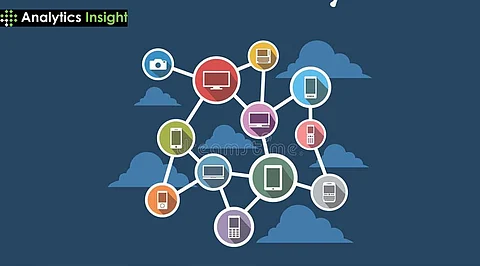

Distributed computing is a model where interconnected computers, or nodes, work together to solve complex problems by breaking tasks into smaller subtasks. Each node operates independently but collaborates with others, enabling efficient resource sharing and parallel processing. This approach is ideal for large-scale tasks like big data processing and high-performance computing that surpass the capabilities of a single machine.
Description: In this model, clients request services from servers, which provide the necessary resources or processing power. It is widely used in web applications and enterprise networks.
Use Cases: Web applications, database access, and network services.
Description: P2P systems are decentralized, allowing each node to act as both a client and a server. This architecture is commonly used for file sharing and content distribution.
Use Cases: File sharing networks like BitTorrent, blockchain networks.
Description: This architecture separates applications into three layers: presentation, application, and data. It enhances scalability and maintainability by allowing each layer to be modified independently.
Use Cases: Web applications, e-commerce platforms.
Description: An extension of the three-tier model, N-tier systems can have any number of layers, each serving a specific function. This architecture is used in complex web applications and enterprise systems.
Use Cases: Large-scale web applications, enterprise software systems.
Description: Middleware acts as an intermediary between different applications or systems, enabling communication and data exchange across different platforms.
Use Cases: Integrating legacy systems, cross-platform data exchange.
Description: Grid computing connects multiple computers across different locations to form a virtual supercomputer, often used for scientific research and complex computations.
Use Cases: Scientific simulations, data-intensive research projects.
Description: Cloud computing provides on-demand access to a shared pool of computing resources, such as servers, storage, and applications. It is a form of distributed computing that supports scalability and flexibility.
Use Cases: Scalable web applications, data storage solutions.
Role: Distributed systems can easily scale up or down by adding or removing nodes as needed. This flexibility allows them to handle increasing workloads efficiently without significant hardware upgrades.
Use Cases: Handling large volumes of data in real-time, adapting to changing computational demands.
Role: By dividing tasks into smaller subtasks and processing them concurrently across multiple nodes, distributed computing significantly reduces processing time and optimizes resource utilization.
Use Cases: Complex scientific simulations, big data analysis, and real-time data processing.
Role: Distributed systems are resilient because they can continue operating even if some nodes fail. This ensures high availability and reliability, making them suitable for critical applications.
Use Cases: Mission-critical systems, cloud services, and data centers.
Role: Distributing data across multiple nodes makes it harder for hackers to access all data at once, enhancing security against cyber threats. Additionally, data replication ensures redundancy and reduces data loss risks.
Use Cases: Secure data storage solutions, protecting against data breaches.
Role: Distributed computing can utilize low-cost hardware and reduce the need for expensive centralized systems. It also optimizes resource use, leading to cost savings over time.
Use Cases: Reducing server costs in data centers, optimizing resource allocation.
Role: Distributed systems can present resources as if they were centralized, simplifying user interaction and management. This transparency allows for easier administration of complex systems.
Use Cases: Simplifying access to distributed databases, managing hybrid cloud environments.
Description: Financial institutions use distributed computing for risk management, fraud detection, and high-speed economic simulations. It helps analyze vast amounts of market data and customer transactions in real-time, enabling informed investment decisions and fraud prevention.
Examples: Real-time transaction processing, portfolio risk assessment.
Description: Cloud services like AWS and Google Cloud utilize distributed computing to provide scalable, reliable, and cost-effective computing resources. This setup allows businesses to store and process data across multiple servers in different locations.
Examples: Scalable web applications, data storage solutions.
Description: Distributed computing is used in IoT to manage and process data from smart devices. It is applied in smart home systems and industrial IoT applications to enhance efficiency and automation.
Examples: Smart home automation, industrial monitoring systems.
Description: Distributed computing is used in smart grid technology to optimize energy consumption and integrate renewable energy sources. It also aids in environmental monitoring by analyzing satellite data.
Examples: Real-time energy management, climate modeling.
Description: Social media platforms and online services use distributed systems to handle high traffic and large volumes of data. This ensures that services remain available even if one server fails.
Examples: Facebook, Twitter, online banking systems.
Description: Massively multiplayer online games (MMOGs) rely on distributed computing to create immersive real-time environments. This allows thousands of players to interact simultaneously.
Examples: World of Warcraft, League of Legends.
Description: Distributed computing is used in scientific simulations, such as climate modeling and gene structure analysis. It speeds up complex computations by distributing tasks across multiple machines.
Examples: Climate modeling, drug discovery research.
Description: Distributed computing helps manage inventory discrepancies and supports distributed order management systems (DOMS) in retail. This ensures seamless operations across online and offline channels.
Examples: Inventory management, order fulfillment systems.
Key characteristics include Concurrency (multiple components executing simultaneously), Independence (components operating independently), Communication (components exchanging information over a network), Transparency (users unaware of the distributed nature), and Fault Tolerance (system continues operating despite component failures).
Advantages include Increased Performance (faster processing through parallel execution), Scalability (easily add more nodes to handle increased workloads), Fault Tolerance (system remains operational even if some nodes fail), and Cost-Effectiveness (efficient use of resources).
Common architectures include Client-Server, Three-Tier, N-Tier, and Peer-to-Peer. Each architecture is suited for different applications and use cases.
While both involve multiple computers, cloud computing typically refers to services provided over the internet, whereas distributed computing is a broader concept that includes various networked systems.
Key challenges include ensuring Data Consistency, managing Network Communication, and maintaining Security across distributed nodes.
Popular tools include Apache Kafka for real-time data processing, Apache Cassandra for scalable databases, and Kubernetes for container orchestration.
Yes, distributed computing is scalable and can be adapted for projects of various sizes, including small-scale applications.
